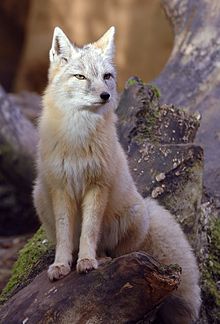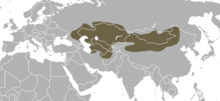Corsac fox
This article needs additional citations for verification. (May 2018) |
| Corsac fox | |
|---|---|

| |
| Scientific classification | |
| Domain: | Eukaryota |
| Kingdom: | Animalia |
| Phylum: | Chordata |
| Class: | Mammalia |
| Order: | Carnivora |
| Infraorder: | Cynoidea |
| Family: | Canidae |
| Subfamily: | Caninae |
| Tribe: | Vulpini |
| Genus: | Vulpes |
| Species: | V. corsac[1]
|
| Binomial name | |
| Vulpes corsac[1] Linnaeus, 1768
| |

| |
| Corsac fox range | |
| Synonyms | |
| |
The corsac fox (Vulpes corsac), also known simply as a corsac, is a medium-sized
Description
The Corsac fox is a medium-sized fox, with a head and body length of 45 to 65 cm (18 to 26 in), and a tail 19 to 35 cm (7.5 to 13.8 in) long. Adults weigh from 1.6 to 3.2 kilograms (3.5 to 7.1 lb). It has grey to yellowish fur over much of the body, with paler underparts and pale markings on the mouth, chin, and throat. During the winter, the coat becomes much thicker and silkier in texture, and is straw-grey in colour, with a darker line running down the back.[4]
For a fox, it has small teeth and a wide skull. One source claims that this species can climb trees and has been domesticated in the past.[5] It is reported to have keen eyesight and hearing and an acute sense of smell. It has a number of scent glands, some of which produce pungent odors,[6] although not so extreme as those found in some other Vulpes species. The glands are found in the anal region, above the base of the tail, and on the paws and cheeks.[4]
Corsac foxes are reported to bark during hunting or when threatening rivals, and to use higher pitch yelps or chirps as alarm calls or social greetings.[4]
Distribution and habitat
Corsac foxes live in the steppes and semidesert of central and northeast Asia. They are found throughout Kazakhstan, Uzbekistan, and Turkmenistan, and through all except the northernmost regions of Mongolia. In the south, their range extends into the more northern parts of Iran, Tajikistan, Kyrgyzstan, Afghanistan, and China, and they can also be found in neighbouring regions of Russia.[2]
Three subspecies are currently recognised:[4]
- Vulpes corsac corsac - northern Kazakhstan, southern Siberia
- V. c. kalmykorum - northern Uzbekistan, Caucasus
- V. c. turkmenicus - southern Uzbekistan, Turkmenistan, China, Mongolia, and neighbouring regions
These foxes inhabit open grassy steppes and semideserts, and avoid dense vegetation and mountainous regions.[2] True deserts with drifting sands are also avoided, as are snowfields more than about 15 cm (6 in) deep.[7] Corsac foxes generally stay far away from human disturbances.
Ecology and behavior


As an adaption to the arid climate in which they live, corsac foxes can forego food and water for extended periods of time.
The Corsac fox is a nocturnal and nomadic hunter of the steppes. It does not have a defended
Reproduction
The mating season starts in January and ends in March. Males will initially fight for access to females, but eventually establish a monogamous bond, and assist in the raising of their young. The mother initially creates a birthing den, which is sometimes shared with other pregnant females, but moves her young to new burrows several times after they are born.[4]
Typically, two to six young are born after a gestation period of 52 to 60 days, although cases of ten kits being born in a single litter have been reported. Newborn kits weigh around 60 g (2.1 oz), and have fluffy, light brown fur that turns yellowish as they age. They are born blind, and open their eyes at around two weeks of age; they begin to eat meat at four weeks, and emerge from the den shortly after. Corsac foxes reach sexual maturity within 9 to 10 months and reproduce in the second year of life.[7] They live up to 9 years in the wild.[4]
Evolution
The corsac fox is one species within a
Very recent subfossil remains dating to 3000 to 1000 B.C.E. have in found in the Crimea and 0 to 1500 B.C.E. in the Donev River Basin in the northern Black Sea region.[16] Fossils of the corsac fox have been recovered from the famous Denisova Cave, known for being the type locality of the Denisova hominins.[17]
Threats
The major threat posed to the corsac fox is poaching, as it is a valuable fur-bearing species and has been harvested by humans since the Bronze Age for subsistence and commercial purposes.[4] It is a slow runner and therefore easily caught by hunters; the population has been reduced in areas where it has been heavily hunted for its fur.[18] Traditionally, the corsac fox is often hunted with trained domestic dogs, saker falcons, and golden eagles, as well as caught with traps set at burrow entrances, leghold traps, and firearms.[4] In the late 19th century, up to 10,000 foxes were killed annually for pelt trade.[11] The general population remains healthy, however, as the corsac fox has proven to be able to withstand great hunting pressures, and their habitats remain intact due to the low human population density in its range.
Other threats include overgrazing by livestock and landscape development; the decline of
References
- OCLC 62265494.
- ^ . Retrieved 19 November 2021.
- ISBN 978-0-19-860572-0.
- ^ doi:10.1644/832.1.
- ISBN 978-1-85043-946-2.
- .
- ^ a b c d e Poyarkov, A.; Ovsyanikov, N. (2004). Sillero-Zubiri, C.; M. Hoffmann; D. W. Macdonald (eds.). Canids: foxes, wolves, jackals and dogs. Status survey and conservation action plan. International Union for Conservation of Nature and Natural Resources/Species Survival Commission Canid Specialist Group. pp. 142–148.
- ^ a b c d Heptner, V. G.; Nasimovich, A. A.; Bannikov, Andrei Grigorevich; Hoffmann, Robert S. (1988). Mammals of the Soviet Union. Vol. 2. Smithsonian Institution Libraries and National Science Foundation.
- .
- ^ Ellis, D.H., Tsengeg, P., Whitlock, P. & Ellis, M.H. 2000. Predators as prey at a Golden Eagle Aquila chrysaetos eyrie in Mongolia. Ibis, 142: 139 – 141.
- ^ a b c Borsa, Carmen. "Vulpes corsac (Corsac fox)". Animal Diversity Web.
- ^ ISBN 978-0801880339.
- S2CID 84733263.
- S2CID 4471252.
- .
- ^ Clark, H.O.; et al. (2009). "Vulpes corsac (Carnivora: Canidae)". Mammalian Species. 832: 1–8. doi:10.1644/832.1.' p3.
- . Retrieved 13 January 2024 – via Elsevier Science Direct.
- JSTOR 3802264.
External links
- . Encyclopedia Americana. 1920.

